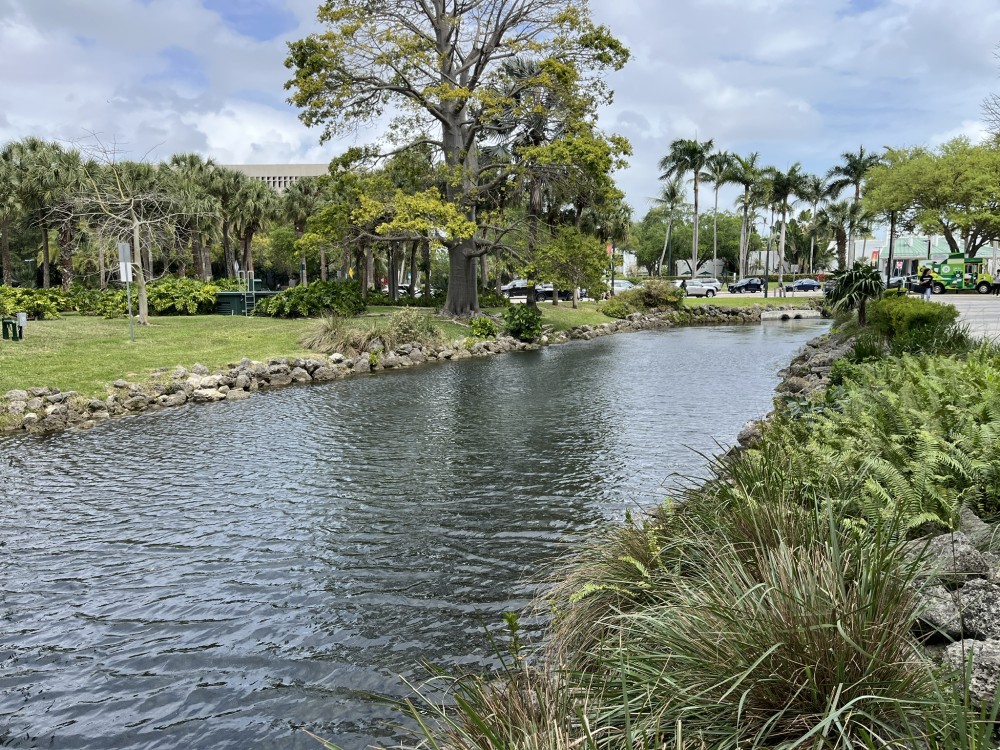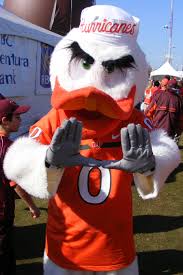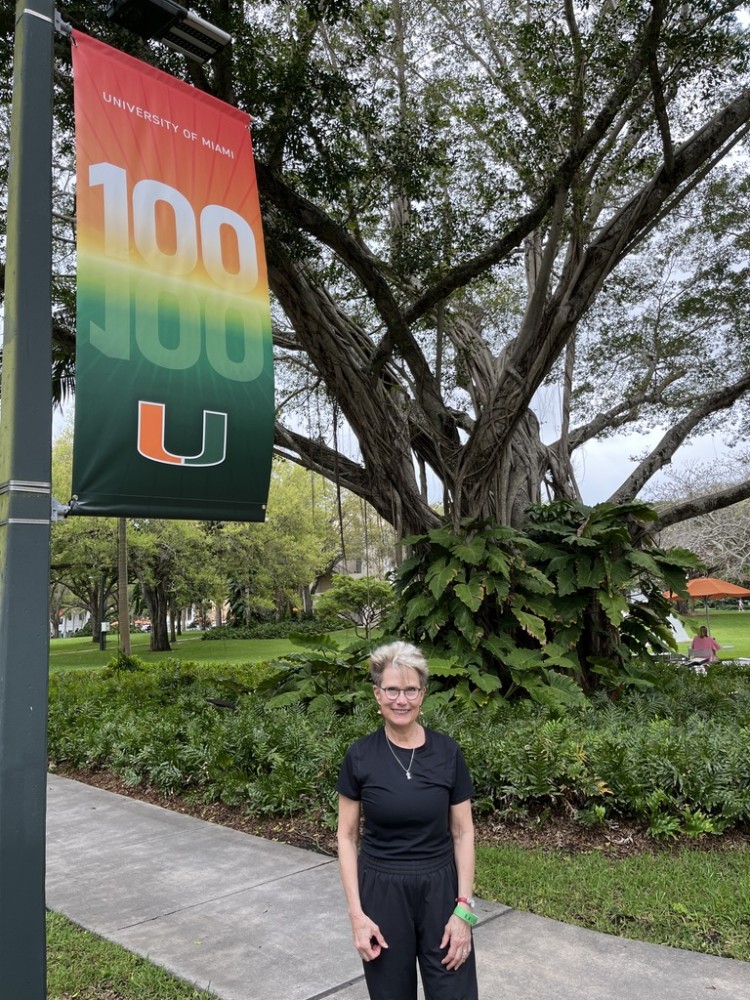U. Miami students work, play in tropical paradise
Fast facts for
University of Miami

Flying down to Miami from a cold winter in Maryland, I was struck by all the green–not just the green and orange of Miami’s famous U, but the green lawns, tropical foliage, and graceful banyan trees that paint the campus. It’s truly a tropical paradise, with lakes and fountains and an incredible pool that boasts multiple swimming lanes divided by a diving well and a three-story diving platform. Though the outdoor and indoor pools are used by their Division I swimming and diving teams, both pools are open to all students.
First things first
The mascot is not a duck; it’s an ibis. That’s one of the first things our admissions presenter, a sophomore business major, told us. Just don’t call Sebastian a duck! Well, Miami, I know my birds. An ibis has a long, long bill that curves downward, and that bill on Sebastian looks like a duck’s to me.


Curiously, all parts of the admissions presentation and tour were handled by highly capable students. They told me they were trained to answer any and all questions that might come up. No adult admissions representatives were present at any point.
Cognates for core
Every UM student has to take at least three courses in each “cognate.” The cognates are STEM, Arts & Humanities, and People & Society. This makes up their core curriculum.
Research available for undergrads
The University of Miami is a top-tier research university, with half-a-billion dollars in research grants. Students can begin doing research as early as their second semester of freshman year. It’s not just reserved for STEM majors; my pre-law tour guide was doing research in criminal justice as a sophomore.
Largest classes have discussion sections
While entry-level classes like Biology 101 could have as many as 150 in the lecture hall, Miami adds a fourth hour (and credit) to such classes to break the class into smaller groups. Run by teaching assistants, the “recitations” or “discussion sections” allow students to review material, work through problems, and get more one-on-one attention. With a student-to-faculty ratio of 11:1, most University of Miami classes have 35 students or fewer.
Housing
A massive construction project on campus will open as Centennial Village in fall 2026. It will have five “residential colleges,” what I’d call living-learning communities. They use the term “residential college” because learning takes place around the clock and outside the traditional classroom. Centennial Village will be for freshmen, who are required to live on campus unless their family lives in the Miami-Dade area. Currently, 92% of freshmen live on campus. By sophomore year, 60% live on campus. Sophomores live in the Lakeside Village.

Rah-rah
The University of Miami has a high “rah-rah” factor, and students benefit from free tickets to all the games. Eighteen Division I ACC teams wear the orange and green colors of the Hurricanes. Go, Canes! In addition to team sports, they have club and intramural sports, and 300+ clubs and organizations. At the Canes Fest during orientation, freshmen zigzag among tables set up to encourage participation.
Work hard, play hard
Tour guides made a point of saying that the overwhelming academic vibe of the U is collaborative. Your peers aren’t competition. It’s not high stress. Our presenter told us that they work hard and play hard. Monday through Thursday, you’re hitting the books, but the weekend is playtime.
Applying to the University of Miami
When you apply to Miami, make sure you apply to the college or school where you want to be, as switching from one college to another can be challenging. You are admitted to the major and college or school that you apply to. For the class that graduated in 2024, 19% were admitted from 54,000 applications. They shared the breakdown of that 19%:
38% were admitted through Early Action; 28% were admitted through Early Decision I;
23% were admitted through Regular Decision; 11% were admitted through Early Decision II
The supplemental essay for Miami for 2025 (updated version to be released in June):
Located within one of the most dynamic cities in the world, the University of Miami is a distinctive community with a variety of cultures, traditions, histories, languages, and backgrounds. The University of Miami is a values-based and purpose-driven postsecondary institution that embraces diversity and inclusivity in all its forms and strives to create a culture of belonging, where every person feels valued and has an opportunity to contribute.
Please describe how your unique experiences, challenges overcome, or skills acquired would contribute to our distinctive University community.
The admissions presenter told us that you should consider the four institutional values of the U when addressing the question. The mission is to transform lives through education, research, innovation, and service. They value “diversity, integrity, responsibility, excellence, compassion, creativity, and teamwork.”
Cost of attendance
The total cost of attendance for the University of Miami for 2024-25? $93,892. But according to the Feb. 9 student newspaper, The Hurricane, “The University of Miami will cost students living on campus $97,774 for the 2025-2026 school year, a more than 4% increase from the year prior.” That’s getting pretty close to $100K. The U promises to meet 100% of demonstrated need in the first year, and 84% of freshmen received aid in fall 2023. Miami is need-blind for domestic applicants, need-aware for internationals.
Schools, Colleges and some interesting majors
School of Architecture
direct admit to five-year B.Arch
College of Arts and Sciences
the largest school, including biology pre-health; global health studies; computer science; materials science; portfolio or audition required for BFA applicants in theater arts
Miami Herbert Business School
popular at the U; includes business analytics with an accelerated master’s degree; entrepreneurship; finance with accelerated master’s, health management and policy; legal studies
School of Communication
includes advertising; broadcast journalism; immersive media; interactive media; motion pictures
School of Education and Human Development
elementary education; sport administration; data analytics and intelligence for social impact
College of Engineering
40% female (national average around 23%); includes aerospace; biomedical; computer; innovation, technology, and design
Rosenstiel School of Marine, Atmospherics, and Earth Science
main campus on Key Biscayne; includes marine affairs; marine biology and ecology; meteorology; oceanography
Frost School of Music
audition or portfolio required for most majors; modern artist development and entrepreneurship; media scoring and production; music education; vocal performance
School of Nursing and Health Studies
state-of-the-art simulation lab, hospital on campus; includes health science; nursing; public health
Pre-Professional Programs
pre-chiropractic, -dental, -medical, -optometry, -podiatry, -veterinary
A wide array of dual-degree programs in the Colleges of Arts & Sciences and Engineering and in the School of Business enable students to earn a bachelor’s and a master’s degree on an accelerated timeline.
In my opinion. . .
The University of Miami is just the right size with under 13,000 students. It’s large enough to have all the perks of a tier-one research university, yet small enough to make personalized attention a reality. Student admissions representatives praised their professors and advisers for the care they exhibit. It’s in a safe, residential suburb of the very large, diverse (and to me, traffic-challenged) city of Miami, rich ground for internships.
If you can afford the hefty price tag, or if your financial award makes the cost of attendance feasible, then working and playing in paradise doesn’t sound bad at all.
